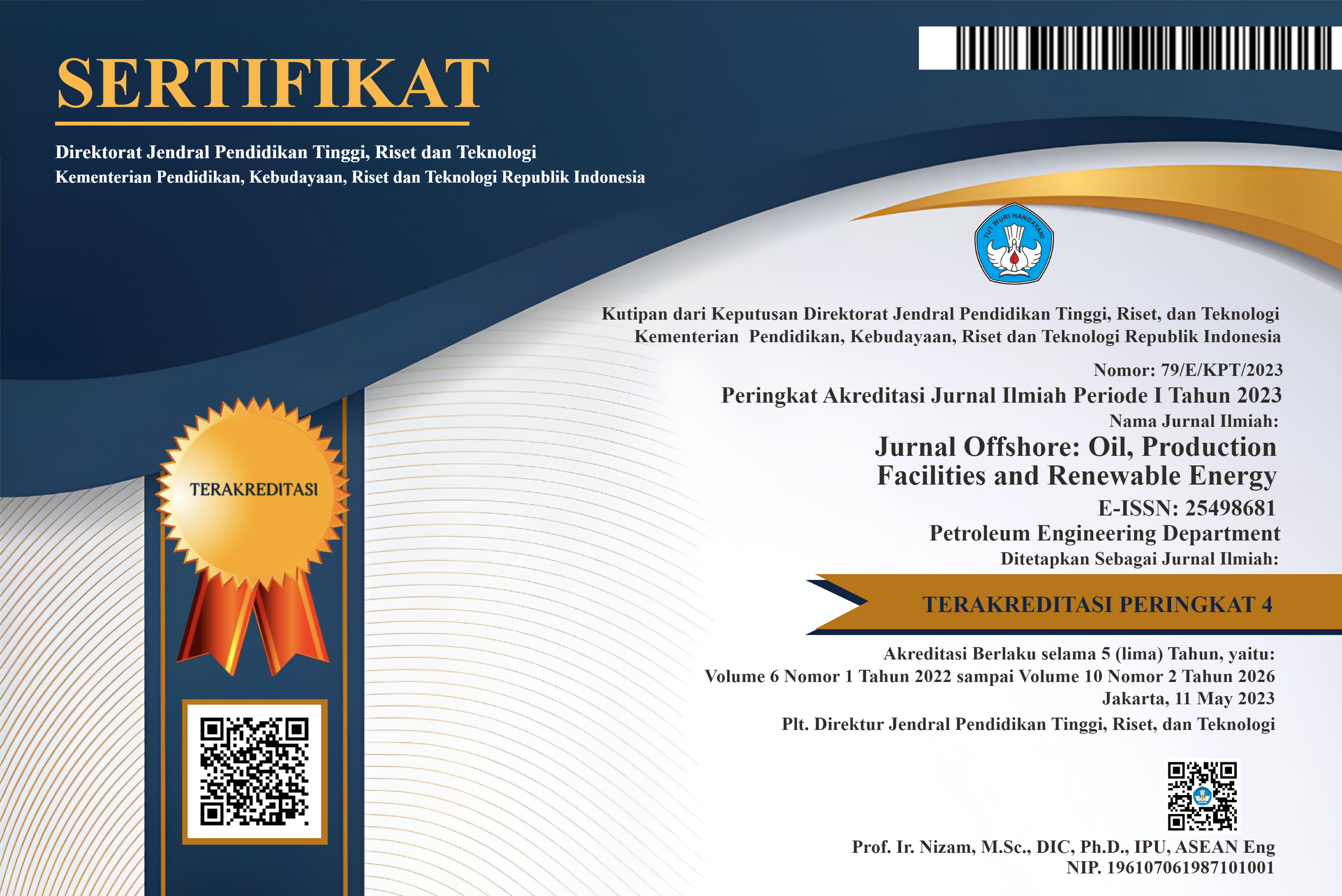Analisis Perkembangan Teknologi Modul Photovoltaic (PV) Untuk Meningkatan Penetrasi Pusat Listrik Tenaga Surya (PLTS) Di Indonesia
DOI:
https://doi.org/10.30588/jo.v7i1.1509Keywords:
Renewable energy, Photovoltaic (PV), LCOEAbstract
Pembangkit listrik energi terbarukan (ET) dapat mengurangi penggunaan pembangkit listrik berbahan bakar fossil yang merusak lingkungan terkait dengan emisi CO2. Photovoltaic (PV) adalah suatu alat yang dapat mengubah energi surya (foton) menjadi listrik arus searah yang merupakan salah satu komponen dalam Pusat Listrik Tenaga Surya (PLTS). Karakteristik tekno ekonomi PV sangat mempengaruhi Levelized Cost of Energy (LCOE) dari PLTS. Penelitian ini bertujuan untuk menganalisis perkembangan teknologi PV dan pemanfaatannya di Indonesia. Metode tinjauan Pustaka yang komprehensif dilakukan dalam penelitian ini. Dari hasil diskusi dan pembahasan disimpulkan bahwa teknologi PV jenis monokristalin memiliki tren pemakaian yang relatif tinggi karena effisiensi/kinerja relatif tinggi, kemudahan fabrikasi, sifat ramah lingkungan, & kehandalan terhadap kondisi lingkungan yang ekstrim (umur operasional lama). Potensi energi surya terbesar di Indonesia terdapat di sekitar wilayah Nusa Tenggara Timur dengan nilai direct normal irradiation sebesar 5 kWh/m2. PLTS berpotensi untuk dibangun di luar Jawa Bali Sumatera mengacu pada tingginya LCOE setempat sehingga nilai feed in tariff yang digunakan dalam kontrak jual beli listrik dapat bersaing dengan nilai LCOE PLTS.
References
AE Solar. (2003). Photovoltaic modules operation in different weather conditions. https://ae-solar.com/solar-panels-in-different-weather/
Benda, V., & Černá, L. (2020). PV cells and modules – State of the art, limits and trends. Heliyon, 6(12). https://doi.org/10.1016/j.heliyon.2020.e05666
BloombergNEF. (2019). Global Solar Investment Report. https://www.climateinvestmentfunds.org/sites/cif_enc/files/knowledge-documents/bnef_2019-10-30_isa-cif_report-final_002.pdf
Boxwell, M. (2012). Solar electricity handbook A simple, practical guide to solar energy-dsigning and installing photovoltaic solar electric systems.
Bozalakov, D., Mnati, M. J., Laveyne, J., & Desmet, J. (2019). Battery Storage Integration in Voltage Unbalance and Overvoltage Mitigation Control Strategies and Its Impact on the Power Quality. Energies, 12. https://doi.org/10.3390/en12081501
Dimitar V. Bozalakov, Joannes Laveyne, M. J. M., & Jan Van de Vyver, L. V. (2020). Possible Power Quality Ancillary Services in Low-Voltage Grids Provided by the Three-Phase Damping Control Strategy. Applied Sciences, 10. https://doi.org/10.3390/app10217876
Fraunhofer Institute for Solar Energy Systems. (2022). Photovoltaics report. https://www.ise.fraunhofer.de/content/dam/ise/de/documents/publications/studies/Photovoltaics-Report.pdf
Fthenakis, V. M., & Kim, H. C. (2011). Photovoltaics: Life-cycle analyses. Solar Energy, 85(8), 1609–1628. https://doi.org/10.1016/j.solener.2009.10.002
Gong, J., Liang, J., & Sumathy, K. (2012). Review on dye-sensitized solar cells ( DSSCs ): Fundamental concepts and novel materials. 16, 5848–5860.
Gross, R., & Green, T. (2016). The Costs and Impacts of Intermittency : Imperial College London.
Gur, I., & Science, E. (2006). Nanocrystal Solar Cells Nanocrystal Solar Cells.
Gusain, A., Faria, R. M., & Miranda, P. B. (2019). Polymer Solar Cells — Interfacial Processes Related to Performance Issues. 7(February). https://doi.org/10.3389/fchem.2019.00061
Hossam-Eldin, A. & Refaey, Mostafa & Farghly, A. (2015). A Review on Photovoltaic Solar Energy Technology and its Efficiency. Conference: 17th International Middle-East Power System Conference (MEPCON’15).
IEA. (2022a). Electricity sector emissions reached their highest-ever level in 2021. https://www.iea.org/data-and-statistics/charts/global-electricity-generation-mix-2010-2020
IEA. (2022b). Renewable Electricity. https://www.iea.org/data-and-statistics/charts/renewable-power-generation-by-technology-in-the-net-zero-scenario-2010-2030
IEA. (2023). Levelised Cost of Electricity Calculator. https://www.iea.org/data-and-statistics/data-tools/levelised-cost-of-electricity-calculator
In, C. C., Se, G., Kato, T., Wu, J., Hirai, Y., Sugimoto, H., & Bermudez, V. (2018). Record Efficiency for Thin-Film Polycrystalline Solar Cells Up to 22 . 9 % Achieved by. IEEE Journal of Photovoltaics, PP, 1–6. https://doi.org/10.1109/JPHOTOV.2018.2882206
IRENA. (2021). RENEWABLE POWER GENERATION COSTS IN 2021. https://www.irena.org/-/media/Files/IRENA/Agency/Publication/2022/Jul/IRENA_Power_Generation_Costs_2021_Summary.pdf
ISE. (2021). Photovoltaics Report. Fraunhofer ISE - PSE, December. https://www.ise.fraunhofer.de/content/dam/ise/de/documents/publications/studies/Photovoltaics-Report.pdf
Kaminski, P. M., Lisco, F., & Walls, J. M. (2014). Multilayer Broadband Antireflective Coatings for More Efficient Thin Film CdTe Solar Cells. 4(1), 452–456.
Kato, K., Hibino, T., Komoto, K., Ihara, S., Yamamoto, S., & Fujihara, H. (2001). A life-cycle analysis on thin- " lm CdS / CdTe PV modules. 67, 279–287.
Kenu E. Sarah. (2020). A Review of Solar Photovoltaic Technologies. International Journal of Engineering Research And, V9(07), 741–749. https://doi.org/10.17577/ijertv9is070244
Luceño-s, A., & Mar, A. (2019). Materials for Photovoltaics : State of Art and Recent Developments. https://doi.org/10.3390/ijms20040976
Luque, A., & Hegedus, S. (2003). Handbook of Photovoltaic Science.
MEMR. (2020). Peraturan menteri nomor 4 Tahun 2020 tentang perubahan kedua atas peraturan menteri energi dan sumber daya mineral nomor 50 Tahun 2017 tentang pemanfaatan sumber energi terbarukan. Kementerian Energi Dan Sumber Daya Mineral. https://jdih.esdm.go.id/index.php/web/result/2032/detail
MEMR. (2021a). National Electricity General Plan 2019–2038. https://jdih.esdm.go.id/index.php/web/result/1973/detail
MEMR. (2021b). Regulation of MEMR No. 169.K.HK.02.MEM.M.2021 about LCOE of PT. PLN (Persero) 2020.
Ong, K. H., Agileswari, R., Maniscalco, B., Arnou, P., Kumar, C. C., Bowers, J. W., & Marsadek, M. B. (2018). Review Article Review on Substrate and Molybdenum Back Contact in CIGS Thin Film Solar Cell. 2018.
Powalla, M., Paetel, S., Hariskos, D., Wuerz, R., Kessler, F., Lechner, P., Wischmann, W., & Friedlmeier, T. M. (2017). Advances in Cost-Efficient Thin-Film Photovoltaics Based on Cu ( In , Ga ) Se 2. Engineering, 3(4), 445–451. https://doi.org/10.1016/J.ENG.2017.04.015
PT. PLN (Persero). (2021). Diseminasi RUPTL 2021-2030.
PT. PLN (Persero). (2022). PLN Statistics.
Rahimi, E., Rabiee, A., Aghaei, J., Muttaqi, K. M., & Esmaeel, A. (2013). On the management of wind power intermittency. Renewable and Sustainable Energy Reviews, 28(x), 643–653. https://doi.org/10.1016/j.rser.2013.08.034
Ramanujam, J., & Singh, U. P. (2017). Environmental Science solar cells – a review. Energy & Environmental Science, 10, 1306–1319. https://doi.org/10.1039/c7ee00826k
Rathore, N., Panwar, N. L., Yettou, F., & Gama, A. (2021). A comprehensive review of different types of solar photovoltaic cells and their applications. International Journal of Ambient Energy, 42(10), 1200–1217. https://doi.org/10.1080/01430750.2019.1592774
Government Regulation of the Republic of Indonesia Number 79 of 2014 concerning National Energy Policy, (2014).
Saga, T. (2010). Advances in crystalline silicon solar cell technology for industrial mass production. 2(July), 96–102. https://doi.org/10.1038/asiamat.2010.82
Sagadevan, S. (2013). Recent Trends on Nanostructures Based Solar Energy Applications : a Review. 34, 44–61.
Sekoai, P. T., & Yoro, K. O. (2016). Biofuel Development Initiatives in Sub-Saharan Africa : Opportunities and Challenges. https://doi.org/10.3390/cli4020033
Sianipar, R. (2014). Dasar perencanaan pembangkit listrik tenaga surya. 11, 61–78.
Suchet, D., Jeantet, A., Elghozi, T., & Jehl, Z. (2020). Defining and Quantifying Intermittency in the Power Sector. Energies(13), 1–12. https://doi.org/10.3390/en13133366
toppr. (2022). Explain the construction and working of the solar cell. https://www.toppr.com/ask/question/explain-the-construction-and-working-of-the-solar-cell/
United Nations. (2015). The Paris Agreement.
Wang, X., & Barnett, A. (2019). The evolving value of photovoltaic module efficiency. Applied Sciences (Switzerland), 9(6). https://doi.org/10.3390/app9061227
World Bank. (2019). PV Potential Indonesia. https://solargis.com/maps-and-gis-data/download/indonesia
Yang, T. C. (2018). Transparent Conducting Aluminium Doped Zinc Oxide for Silicon Quantum Dot Solar Cell Devices in Third Generation Photovoltaics. January 2016. https://doi.org/10.13140/RG.2.2.13188.22407
Zhang, Z. (2016). Making the Transition to a Low-Carbon Economy : The Key Challenges for China : Transition to a Low-Carbon Economy Special Issue Making the Transition to a Low-Carbon Economy : The Key Challenges for China. June. https://doi.org/10.1002/app5.138
Zhao, J., Wang, A., Green, M. A., & Ferrazza, F. (1998). 19.8% Efficient “Honeycomb” Textured Multicrystalline and 24.4% Monocrystalline Silicon Solar Cells. Applied Physics Letters, 73(14), 1991–1993. https://doi.org/10.1063/1.122345
Zhou, D., Zhou, T., Tian, Y., Zhu, X., & Tu, Y. (2018). Perovskite-Based Solar Cells : Materials , Methods , and Future Perspectives. 2018.
Zhou H., C. Q. and L. G. (2014). Interface Engineering of Highly Efficient Perovskite Solar Cells. Science, 345 (6196), 542–546. https://doi.org/10.1126/science.1254050
Downloads
Published
How to Cite
Issue
Section
License
Authors retain copyright and grant the Jurnal Offshore right of first publication with the work simultaneously licensed under a Creative Commons Attribution 4.0 International License that allows others to share (copy and redistribute the material in any medium or format) and adapt (remix, transform, and build upon the material) the work for any purpose, even commercially with an acknowledgement of the work's authorship and initial publication in Jurnal Offshore. Authors are able to enter into separate, additional contractual arrangements for the non-exclusive distribution of the journal's published version of the work (e.g., post it to an institutional repository or publish it in a book), with an acknowledgement of its initial publication in Jurnal Offshore. Authors are permitted and encouraged to post their work online (e.g., in institutional repositories or on their website) prior to and during the submission process, as it can lead to productive exchanges, as well as earlier and greater citation of published work (See The Effect of Open Access).















